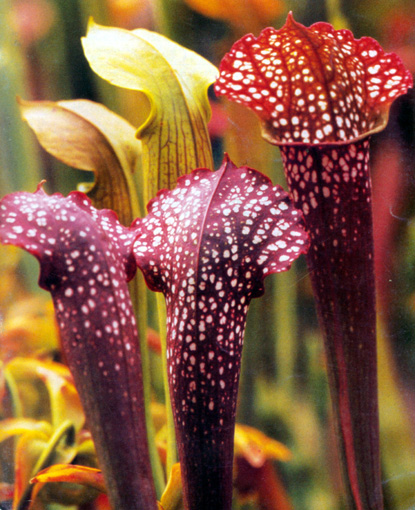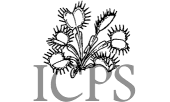|
Carnivorous Plant Newsletter
Volume 27, Number 2, June 1998, pages 38-40
NEW CULTIVARS
Sarracenia 'Dixie Lace'
Sarracenia 'Ladies-in-Waiting'
NEW CULTIVARS OF SARRACENIA FROM NORTH CAROLINA:
SARRACENIA 'DIXIE LACE' AND 'LADIES-IN-WAITING'
--- LARRY MELLICHAMP • Charlotte, NC • USA
--- ROB GARDNER • Chapel Hill, NC • USA
Received: 7 April 1998
Keywords: cultivar: Sarracenia 'Dixie Lace', Sarracenia 'Ladies-in-Waiting'.
Introduction
We are presenting two new cultivars of Sarracenia which have been noted in several horticultural trade magazines since the autumn of 1997 (e.g., American Nurseryman, December 15, 1997; Nursery Management and Production, Vol. 14(2) 1998). Both have been asexually propagated in tissue culture by Dr. Sherry Kitto at he University of Delaware and subcultured by Sandra King at SMK Plants. They have been released commercially by Niche Gardens: Sarracenia 'Dixie Lace' was in their Fall 1997 catalog; 'Ladies-in-Waiting' was in the Spring 1998 catalog.
Both cultivars resulted from a long period of hybridization and selection of Sarracenia that started about 1985 as a collaborative effort between the two authors. Other cultivars we produced were registered in Carnivorous Plant Newsletter in 1987 (16:2, pp. 39-42). Of these, 'Moore's Melody' still persists and will be commercially available in the future; the others have proven unsatisfactory in the long run or have gone extinct! To our knowledge, Sarracenia 'Dixie Lace' is the first named Sarracenia hybrid cultivar to be sold commercially as tissue cultured material. Sarracenia 'Ladies-in-Waiting' is the second.
We still follow the general criteria for selecting cultivars that we reported in 1987. Our two new cultivars have been under observation for 9 and 13 years. They have proven to be outstanding and interesting plants that grow that well and attract attention when displayed. They were also survivors in the many efforts to get hybrids into tissue culture. It was not easy, and we feel fortunate to have come this far with them.
Sarracenia 'Dixie Lace'
This specific clone was selected in 1993. It resulted from a 1988 pollination at the University of North Carolina at Charlotte (hereafter UNCC) that germinated in 1989 (seed lot 88-14). The female parent was a natural hybrid between Sarracenia leucophylla and S. alabamensis subsp. wherryi (given the unregistered horticultural name "Cotton Patch") collected in Perdido, Alabama in 1985 and grown at the McMillan Greenhouse at UNCC. The pitchers resemble S. leucophylla, although only up to 30 cm (12 inches) tall, and are distinctly pubescent. The male parent was an artificial hybrid of Sarracenia psittacina and an unknown partner, probably S. purpurea, made by Dr. Warren Stoutamire, and given to the North Carolina Botanical Garden (hereafter NCBG) prior to 1985. That hybrid was unofficially called "Snorkle" and continues to be grown in the collections of both institutions.
The pitchers are shaped like a simple smoking pipe lying flat on the ground with the bowl end turned up. The pitchers are uniformly deep red, and up to 15 cm inches) long.
'Dixie Lace ' is a distinctive plant (Figure 1). It quickly grows into a multi-crowned clump and flowers freely. Its sturdy pitchers are produced throughout the growing season. Many pitchers survive well into the winter, even after severe cold (down to -7°C or 20°F). The plant has survived temperatures of -18°C (0°F). However, protection from prolonged cold allows the plant to remain attractive throughout the winter. Flowering occurs at mid-season, and the red flowers are similar to those of the parents. 'Dixie Lace' has been grown in full sun outdoors in beds and in pots in a medium of peat:coarse silica sand (1:1). The pitchers are about 25 cm (10 inches) tall, and are poised erect to slightly arching outwards. The hood shows the S. psittacina character of being squared-off at the front and tightly closed when the pitchers first elongate. Later, the hoods of most pitchers flatten and form an opening underneath a strongly rounded hood with laterally flared sides. The pitcher tube gradually enlarges to more than 4 cm (1.5 inches) wide below the hood. The surface of the pitcher tube is rich maroon with many white spots between strong dark red veins. The hood has a yellowish-green background with a very strong pattern of large primary and smaller secondary veins—in strong light the hood becomes golden toned. White spots on the hood may be absent or occur in patches. In summary, the erect pitchers with squared-off hood fronts, the very strong pattern or dark red veins, and the two-tone appearance of the upperpitcher/hood combination are distinguishing features of this hybrid selection.
The name 'Dixie Lace' is in reference to the Deep South of the USA where the parents are native, and the strong lacy appearance of the reticulate vein pattern on the hood. Since the pitchers vary in the detail of color and form of the hood over the growing season and under different amounts of light, we feel this cultivar offers a great charm that teases the imagination in trying to describe its subtle nuances of character

Figure 1: Sarracenia 'Dixie Lace'.
Sarracenia 'Ladies-in-Waiting'
Dr. Warren Stoutamire gave this specimen to the NCBG in 1985 as a single seedling (NCBG accession number 1985-0885). It is a hybrid of Sarracenia leucophylla x (S. rubra x S. psittacina). The pitchers are 35 cm (14 inches) tall, or more. They are stiffly erect with a very slight outward curve, and are completely hairless on the outer surface. The upper 1/3 of the pitcher gradually enlarges and bears a slightly arching hood with a gaping mouth (orifice). The opening of the orifice can be up to 3 cm (1.25 inches) wide. The hood is 3-4 cm (1-1.5 inches) long and 5-6 cm (2-2.5 inches) wide with a distinct ruffle along the edge, reminiscent of the S. leucophylla parent. Stiff hairs to 1 mm long are inside the hood. The modest size of the pitchers comes from the S. rubra parent. The small red flowers are also very much like S. rubra. Characteristic of the S. psittacina parent, the back of the hood and upper pitcher have prominent irregular white spots, and the pitcher's interior is profusely lined with long hairs to 2 mm long. You can see this hybrid exhibits characteristics of its three parents.
The coloration of the pitchers is remarkably beautiful (see Front Cover). The green of the lower pitcher gradually gives way to a uniform rich maroon-red in the upper half and hood. The enlarged upper pitcher and hood are marked with distinct white spots. The late-summer pitchers in the cover photo were grown in full sun all day long and are especially well colored. The pitchers retain their color well into the fall, but turn brown in winter, whether exposed to freezing temperatures or not. This clone survives temperatures as low as -18°C (0°F) with no adverse affects as long as the roots are not exposed to drying. Pitchers are produced all season—an advantage over the seasonal pitcher production of the S. leucophylla parent. Taking a cue from S. leucophylla genes, however, the best and largest pitchers are exhibited in late summer and fall. There are no phyllodia. The plant as a whole is thin-textured but sturdy, holding up to rain and wind. Yet there is a strong feeling of elegance and delicate ruffles, leading us to contrive the affectionate name 'Ladiesin-Waiting', alluding to association with royalty.
Both cultivars are available through Niche Gardens (1111 Dawson Road, Chapel Hill, NC 27516 USA, http://www.nichegdn.com) and Plant Delights Nursery (9241 Sauls Rd., Raleigh, NC 27603 USA, http://www.plantdel.com).

Front Cover: Sarracenia 'Ladies-in-Waiting'.
|

